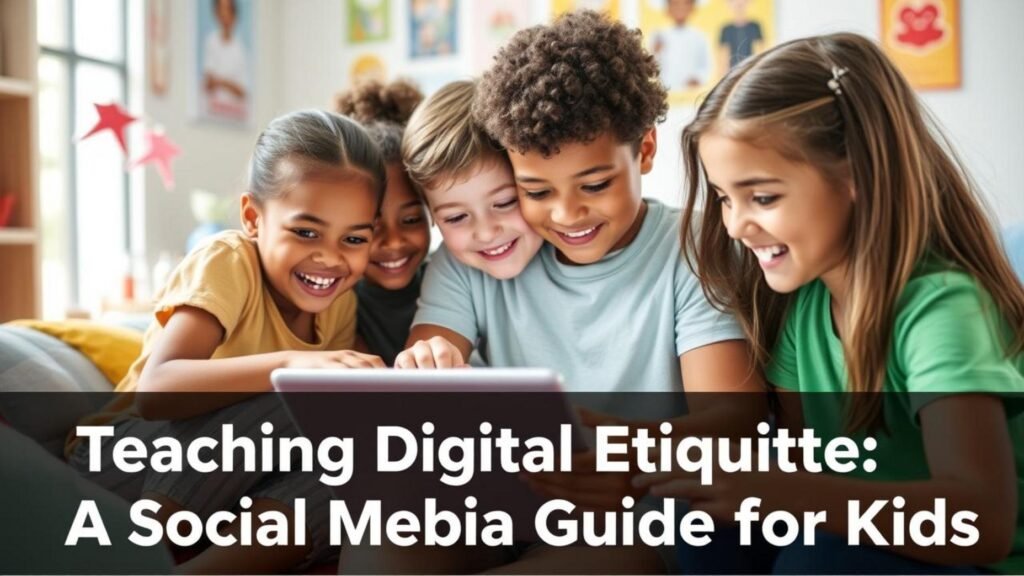Understanding Digital Etiquette: What Every Kid Should Know
Digital etiquette, often referred to as “netiquette,” is a collection of rules that dictate how individuals should behave in the online realm. Teaching kids about digital etiquette is essential as they navigate social media and other online platforms. Understanding how to communicate respectfully and responsibly fosters a positive virtual environment that encourages healthy interactions.
Positive Behaviors to Embrace
Engaging in positive behaviors online means showing respect for others and fostering a supportive community. Kids should be encouraged to communicate kindly, share uplifting content, and celebrate others’ achievements. A critical aspect of digital etiquette is remembering that a real person stands behind every screen, deserving of kindness and respect. As outlined by the OpenAI, teaching children to think before they post can lead to more thoughtful online interactions.
Additionally, practicing gratitude by thanking others for their contributions can strengthen online relationships. Kids need to remember that every interaction counts, and being a good digital citizen can inspire their peers to act similarly.
Avoiding Harmful Practices
Conversely, harmful behaviors like cyberbullying can have severe repercussions for both victims and perpetrators. Engaging in negative speech, spreading rumors, or excluding others online creates a toxic environment. Researchers at the University of New Hampshire found that cyberbullying can lead to serious mental health issues among youth, underscoring the importance of teaching kids about the implications of their online behavior.
It’s vital to engage children in conversations about empathy and the impact of their words. Encouraging them to report instances of cyberbullying, whether they are experiencing it or witnessing it, promotes a culture of accountability and support. Thus, children learn that standing against negativity is just as crucial as fostering positivity.
By instilling these principles of digital etiquette, kids can navigate the online world with respect and integrity, creating enjoyable and safe experiences on social media platforms. For more tips on enhancing online safety for children, check out our guide on effective AI prompts.
Online Safety for Children: Protecting Personal Information
In today’s digital age, understanding digital etiquette and ensuring online safety for children is more crucial than ever. One of the key aspects of maintaining safety online is managing personal information effectively. Here are some essential tips to help children navigate this complex landscape:
1. Understand Privacy Settings
Encourage children to familiarize themselves with the privacy settings on the social media platforms they use. Most platforms allow users to control who can view their profiles, posts, and personal information. Teaching kids to set their profiles to private can help protect their information from unwanted attention. For detailed guidance on privacy settings, you can explore resources from Common Sense Media.
2. Be Cautious About Sharing Personal Details
It’s vital to discuss with children what constitutes personal information. Sharing details like their full name, home address, phone number, school name, and even pictures can expose them to risks when made public. Encourage them to think before they post: “Would I be comfortable sharing this with a stranger?” According to KidsHealth, being selective about what they share helps mitigate these risks.
3. Recognize the Risks of Oversharing
Oversharing can lead to various dangers, including cyberbullying and predatory behavior. Teach kids that while it’s amusing to share experiences, they must be mindful of potential consequences. Reinforce the idea that not everyone online has good intentions. For additional insights on online sharing, check out StopBullying.gov for valuable resources.
4. Discuss the Importance of Online Anonymity
Help children understand that maintaining a level of anonymity online can aid in protecting their personal safety. Encourage them to use nicknames or avatars instead of real names or photos when engaging in online communities. This can prevent unwanted attention and maintain privacy.
5. Monitor Their Online Activity
Regularly check in on the platforms your children are using and their activities. Maintain an open dialogue about their online experiences, ensuring they feel safe to share any uncomfortable encounters. Open communication is key to ensuring online safety for children.
By emphasizing these aspects of digital etiquette, parents can empower their children to navigate the online world safely. For further discussions on enhancing online experiences with a focus on safety, consider reading our related article on managing digital spaces effectively at Digihetu Blog.
Kid-Friendly Social Media Platforms: Choosing the Right Space
Navigating the world of social media can be challenging for children, especially with the plethora of options available. It is crucial to guide kids toward age-appropriate platforms that provide a safe and positive environment while fostering healthy interaction. Here, we evaluate some of the most popular kid-friendly social media platforms and highlight the benefits of choosing the right spaces for online engagement.
Safe Spaces for Connection
Many platforms specifically cater to younger audiences, designed with safety features that prevent exposure to inappropriate content and interactions. For instance, platforms like Kidzworld offer a moderated space where kids can chat, share interests, and make friends, promoting a sense of community while emphasizing digital etiquette. These environments often have strict user age requirements and monitoring protocols, helping to enhance online safety for children.
The Dangers of Unfiltered Sites
Conversely, using unfiltered or generic social media sites can expose children to harmful content and risky interactions. The unregulated nature of platforms like TikTok or Instagram can lead to exposure to cyberbullying, inappropriate material, and privacy violations. Such environments often encourage behaviors counter to the principles of digital etiquette. Thus, it is essential to deter children from these platforms or ensure they have the knowledge and tools needed for safe online navigation.
Promoting Healthy Interaction
When selecting a social media platform for children, it’s essential to discuss the expectations of behavior online. By choosing kid-friendly platforms, children can learn valuable lessons about digital etiquette, such as how to communicate respectfully, recognize the importance of privacy, and understand the consequences of sharing personal information. For instance, platforms like Yubo encourage users to create meaningful connections through interests, thus reinforcing positive social skills in a protected environment.
In conclusion, the importance of choosing the right social media spaces cannot be overstated. With age-appropriate platforms, children can safely explore their interests while developing essential digital etiquette skills that will serve them throughout their lives. For more guidance on keeping your kids safe online, see our guide on online safety for children.
The Role of Digital Footprint: Understanding Your Online Presence
In today’s digital landscape, every action taken online contributes to a child’s digital footprint. This footprint is the trail of data they leave through various online activities, including social media posts, comments, and even likes. Understanding the implications of a digital footprint is crucial for kids, as it can significantly impact their future opportunities—from college admissions to job prospects.
The Importance of Curating Content
Instead of simply deleting negative or unwanted content, children should be encouraged to think critically about their online presence. Curating content thoughtfully allows them to build a positive digital identity. As noted by the Education Corner, a well-managed digital footprint can enhance personal branding and showcase their skills and interests effectively.
Encouraging Responsible Sharing
When kids share content online, they should consider the long-term effects. For instance, a fun photo shared during a moment of spontaneity may seem harmless but could lead to unintended consequences later on. Teaching them to ask questions like, “Would I be comfortable if this content were seen by my future employer or college?” can foster a more conscientious approach to online sharing.
Navigating Online Safety for Children
Part of understanding digital etiquette involves recognizing the broader implications of their online activities. According to National Cyber Security Alliance, educating children about online safety goes hand-in-hand with understanding their digital footprint. They should be aware that actions such as oversharing personal information can expose them to risks, making online safety for children paramount in fostering a healthy digital environment.
In conclusion, encouraging kids to be mindful of their digital footprint is a critical step in teaching digital etiquette. By curating their online presence thoughtfully, children can protect their future while enjoying the benefits of social media. For practical tips on guiding children in thoughtful content sharing, explore our resources on social media automation and essential digital tools to foster creativity while ensuring safety.
Encouraging Positive Interactions: Creating a Supportive Online Community
In today’s digital landscape, fostering a supportive online community is essential for cultivating positive interactions among children. Encouraging kindness, celebrating achievements, and promoting inclusivity can significantly influence young users’ online experiences. Here’s how parents and educators can instill these values in their children.
Promote Kindness and Positivity
Teaching kids to be kind online is as vital as in real life. Encourage them to engage in uplifting conversations, leave positive comments, and show appreciation for others’ posts. Simple acts of kindness, such as complimenting a friend’s artwork or congratulating someone on a milestone, can create a domino effect, inspiring others to mirror this behavior. Research indicates that supportive online environments can improve self-esteem and foster a sense of belonging in children (Psychology Today).
Celebrate Achievements
Acknowledging and celebrating peers’ achievements, big or small, is vital to building a supportive community. Encourage your child to share their successes and to celebrate those of others. This can be achieved through encouraging messages, shout-outs, or even virtual celebrations. Recognizing the accomplishments of their peers contributes to a culture of encouragement, combating negative behaviors often seen in online spaces.
Avoid Gossip and Exclusion
Negative behaviors like gossip and exclusion can quickly become rampant in online communities, leading to feelings of isolation and distress among children. It’s critical to discuss the implications of these actions with kids. Teach them the importance of inclusivity and to stand against negative comments or behaviors. Direct children to think before they post and consider how their words may affect others. Strategies for addressing gossip, such as promoting open dialogue and reporting harmful content, can help create a more respectful environment.
By focusing on these principles of digital etiquette, children can learn to navigate the complexities of social media while positively contributing to their online communities. With ongoing conversations and guidance, we can empower the next generation to foster an online environment that thrives on kindness, support, and inclusivity. For more tips on digital etiquette, check out our article on maximizing online success for kids.
Sources
- Digihetu Blog – Online Safety for Children
- Common Sense Media – Privacy Settings
- KidsHealth – Personal Information
- Education Corner – Digital Footprint
- Psychology Today – Positive Online Communities
- StopBullying.gov – Online Sharing
- National Cyber Security Alliance – Online Safety for Children
- Kidzworld – Safe Space for Connection
- Yubo – Safe Social Media
- University of New Hampshire – Understanding Cyberbullying



